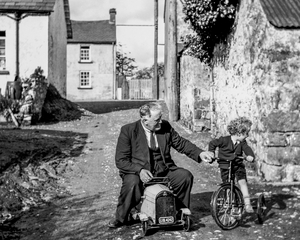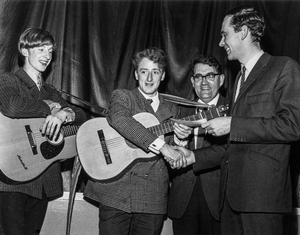When I first stumbled across the photographs of Bobbie Hanvey, I thought I had found an undiscovered master — perhaps another sort of Vivian Maier. My heart skipped a beat. But when I dug a little deeper, I realized that he was quite well-known in Northern Ireland, where he has been documenting the culture in photos and audio for more than 35 years. Only recently, however, has his work become available to a wider audience.
Bringing Bobbie's photographs to America is part of the mission of his son, Steafán Hanvey, a singer/songwriter on tour with a new album, called Nuclear Family, as well as a multimedia presentation showcasing original music alongside his father's work.
When I spoke with him recently, Bobbie Hanvey was quick to say, "I'm not an artist," although the mind-boggling scope of his archive says otherwise.
Since 1977, he's recorded over 1,000 interviews for his radio program, The Ramblin' Man, which airs on Downtown Radio. And Boston College Libraries recently acquired more than 75,000 of his photographs, which capture the political and cultural life of Northern Ireland since the 1970s.
When I called Dr. Robert O'Neill, Burns librarian at Boston College, to talk more about Bobbie Hanvey, he couldn't have been more excited. He first met Bobbie in 2000, and was so impressed with his work that he set about acquiring a vast majority of his archive. Thousands of Hanvey's images are now hosted in the Burns Library collection on Flickr.
"Bobbie Hanvey is extraordinarily talented. He just has an insatiable appetite for photographing" he said. "He put himself at great risk throughout The Troubles covering individuals and scenes that were oftentimes still in the midst of happenings — bombs, explosions, meetings with both sides — he had an incredible ability to win the confidence of everyone from Ian Paisley to the toughest paramilitiaries."
Bobbie Hanvey was born in Northern Ireland in 1945, and his father, a lumberjack, was known for going everywhere with a camera. In 1962, his father gave him his own camera and a microphone, setting the course of Bobbie's life as an award-winning photojournalist and radio interviewer.
Hanvey quit school at 15, because he "thought life was more exciting," and eventually took a job as a psychiatric nurse at Downshire Hospital in Downpatrick. It was there that he taught himself photography and began recording patients as they sung traditional songs. He also traveled and recorded as a folk musician during the 1970s and '80s.
"What's different about him from other photographers is that he seems to have amazing access to people of different classes," said Dr. Pauline Prior, a lecturer in social policy at Queen's University, Belfast, in Northern Ireland.
"He's eccentric, sociable — something you and I would see as ordinary, and he would take a picture and make it extraordinary. You know how artists are," she said.
Arguably, Hanvey's photographic work rivals that of great American photographers such as Walker Evans, Dorothea Lange, and even the spot news artist Weegee. He's covered everything and everybody who was significant in Northern Irish life — from ordinary people to police, paramilitaries, poets, playwrights and musicians. He also obsessively covered The Troubles — a time of violent conflict between Loyalists (mostly Protestant) and Republicans (mainly Catholic) between the 1960s and 1988.
Steafán Hanvey was born in the midst of this melee, a few months after Bloody Sunday in 1972. And he grew up in a nontraditional household, where his father both held jam sessions with all types of musicians, and also leaped out of bed at night to photograph explosions and bombings.
"I would hear my dad getting up and running down the stairs, and sometimes he would say, 'Come on with me here,' and he would be on the way to the aftermath of a fire, or a bomb, or an explosion," he said. "Then I would get up the next morning and go to school, and while all my peers had been fast asleep, I'd been out on this adventure. It was very exciting for a young boy to have been exposed to that kind of life."
Steafán started a rock band in the 1980s, has degrees in American studies and international politics, and has since recorded two albums of personal, soulful music. And, bringing the family's creative endeavors full circle, he's now touring America and Canada with his songs and a multimedia presentation called "Look Behind You."
We had long conversations over Skype, email and from a radio studio about the artist's role in society — especially a modern society defined by conflict. Steafán is thoughtful, intelligent and reflective about the culture and family that shaped him, as well as how it has influenced and defined his recent album.
"I'm investigating the notion that art gives order and logic to chaos," he said. "I guess I recently thought of explaining Nuclear Family as it's someone trying to make sense of what surrounding chaos sounds like."
The role of an artist in society can be complicated; and when society itself is complicated — as it has been in Northern Ireland for many years — then the artist's role can be even harder to define. Steafán is looking back at his father's legacy, and examining how creating art in a time of conflict influences both the art and the artist.
"I'm very proud of him ... I think he's very good," said Bobbie. "I think he's carrying on the torch. If he was in the Olympics he'd be carrying the torch for me."
"My dad says, 'Nobody ever leaves Northern Ireland,' and it's true," said Steafán. "It's what's made us who we are. It's made me what I am, and you can leave it, but you are always wanting to go back."
9(MDE1MTIxMDg0MDE0MDQ3NTY3MzkzMzY1NA001))
Transcript
LINDA WERTHEIMER, HOST:
In honor of Father's Day, we have the story of Bobbie and Steafan Hanvey, a father and son from Northern Ireland. Bobbie is a well-known news photographer and broadcaster there, the longtime host of "The Ramblin' Man" radio program.
(SOUNDBITE OF RADIO SHOW, "THE RAMBLIN' MAN")
BOBBIE HANVEY: I'm very delighted that Sean Garland is my guest tonight. I'm Bobbie Hanvey, "The Ramblin' Man," and as always, you're very welcome to our program.
RENEE MONTAGNE, HOST:
For over 30 years, in photographs and radio interviews, Bobbie Hanvey has documented life in Northern Ireland. He's captured the faces of poets and priests, inventors and distillers, scholars and Ireland's gypsies - even the homes of Irish ghosts.
WERTHEIMER: His subjects also include some of the turbulent events and polarizing figures of The Troubles: the period of violent upheaval in Northern Ireland's recent past.
MONTAGNE: As a young boy, Steafan Hanvey tagged along with his father to early-morning scenes of violence - the aftermath of bus-bombings and arson-attacks - as well as marches, protests and funerals.
WERTHEIMER: The son is now grown up and an accomplished musician. Ahead of Father's Day, both men spoke to NPR's Coburn Dukehart. With music from Steafan Hanvey, here is their story.
(SOUNDBITE OF MUSIC)
STEAFAN HANVEY: Everybody used to ask me, you know, do you want to be like your daddy when you grow up? From a very early age, I got the impression that, you know, this was somebody very important. My name is Steafan Hanvey. I'm from Down Patrick in County Down, Northern Ireland.
BOBBIE HANVEY: Bobbie Hanvey, Down Patrick, County Down, Northern Ireland. Living through Northern Ireland in The Troubles was a very nervous time. The fact that I was taking photographs of The Troubles and recording the people involved in The Troubles, it did keep me sane because it gave me something else to think about other than myself.
(SOUNDBITE OF MUSIC)
BOBBIE HANVEY: I used to listen to the radio all the time. I had a scanner, and I used to end up in places before the police even got there.
STEAFAN HANVEY: I would hear my dad getting up and running down the stairs. And sometimes, you know, if I heard him, I would meet him in the stairs and he'd say, come on with me here. He'd be out on the way to the aftermath of a fire or a bomb - you know, an explosion that had gone off.
(SOUNDBITE OF MUSIC)
STEAFAN HANVEY: It was exciting, you know. And then I would get up the next morning and go to school. And while all my peers had been sound asleep dreaming, I'd been out on this adventure, you know?
(SOUNDBITE OF MUSIC)
STEAFAN HANVEY: He's an accomplished photographer, radio celebrity, character, eccentric and...
BOBBIE HANVEY: I'm not eccentric.
STEAFAN HANVEY: I was being polite.
(LAUGHTER)
(SOUNDBITE OF MUSIC)
STEAFAN HANVEY: I think you're chosen, really, by whatever it is that drives you. In my father's case, his mode of expression was the microphone and the camera. And mine is through singing and writing songs. There's a catharsis involved, of course, in creating all of those things.
(SOUNDBITE OF MUSIC)
STEAFAN HANVEY: I think he is an artist.
BOBBIE HANVEY: No, I'm not an artist. No.
STEAFAN HANVEY: It's my turn.
BOBBIE HANVEY: Art is something that is - it's a repackaging thing and a sanitizing thing, a part of history that wasn't very nice. And it makes it more acceptable to people later on. You know, I just think that they're just photographs of a time that happened, and I was there. I was - if you like, it was like being a sniper. You look through the camera the same way as a sniper looks through a gun. You press the shutter, he presses the trigger, and you hope to get something. You know, I don't think there's much else involved to it. I think it's mainly mechanical. There's no way I could call it art.
(SOUNDBITE OF MUSIC)
BOBBIE HANVEY: Steafan has come through it all right. He's learned the guitar. He can sing great. He can write good songs. I think he's carrying on the torch. If he was in the Olympics, he'd be carrying the torch for me. You live as long as you have to live, and I reckon that I've got five to seven years left. But I really had a great time here in Northern Ireland.
(SOUNDBITE OF MUSIC)
WERTHEIMER: Photographer and radio host Bobbie Hanvey, with his son, Steafan.
MONTAGNE: Steafan Hanvey is now touring the U.S. with his father's work, a show called "Look Behind You: A Father and Son's Impression of Northern Ireland through Photograph and Song." You can see them together, discussing their work, at NPR.org.
(SOUNDBITE OF SONG, "THE RAMBLIN' MAN")
THE CORRIB FOLK: (singing) I am a ramblin' Irish man. And Ulster I was born in, and many's a happy hours I spent... Transcript provided by NPR, Copyright NPR.
300x250 Ad
300x250 Ad
































